
by Valley Gadfly | Apr 28, 2017 | Valley Gadfly
It’s May in the Cherry Creek Valley. Kids are playing in the sprinklers, there are festivals every weekend and everywhere you look things are in full bloom. Wander neighborhood streets, gardens and parks and they’re pumping out beautiful foliage and fabulous flowers. It’s the month to get tanned, rested and ready for summer.
May is one of the most gorgeous months of the year. The bees are buzzing, the flowers are blooming and the birds are chirping. It is emblematic of love and success.
Here are our surefire sunlit choices for shopping, dining and entertainment to make the month shine bright, beautiful and bold like a bountiful bouquet of flowers:
3 May is with us; the month of sunshine, flowers and the fun Furry Scurry two-mile walk around Wash Park May 6, 9 a.m. Vendors offer pet-related products, plus food, demos and contests. Information: 303-751-5772.
3 Spring for Denver Recycles’ free mulch giveaway May 6 at Havana Nursery and four satellite sites, 8 a.m.-2 p.m. Information: 720-913-1311.
3 May is the month of big celebrations so don’t miss Denver Film Society’s 40th May 11 at Wings Over the Rockies, 7 p.m. Information: 303-595-3456.
3 Maybe May is lucky so head to the Hold ’Em Poker fundraiser game in Phillips Hall at the JCC May 18, 5:30 p.m. Information: 303-316-6312.
3 The most special day in May is Mother’s Day so show her how special she is by treating her at the Valley’s favorite neighborhood Italian Bistro Shells & Sauce on Sunday, May 14. Reservations: 303-377-2091.
3 Another May new buds and flowers shall bring: Ah, it’s the last month of spring and time to treat yourself to energy efficient window shades from Cherry Creek Shade & Drapery. Information: 303-355-4223.
3 May is magical so catch the Illusionists playing at the Ellie Caulkins Opera House live from Broadway, May 19-21. Information: 303-893-4100.
3 For a marvelous May day custom take free Lawn Bowling lessons at Wash Park, May 20, 11 a.m. Info: washingingtonparklawnbowlingclub.com.
3 May is a fun time for outdoor festivals, food and fun and nothing could be finer than Colorado Corks & Cuisine at Four Mile Historic Park May 25, 5:30-8:30 p.m. Enjoy brewed, distilled, vented, and plated summer creations at this out-of-doors artisans event. Your support for the annual Four Mile fundraiser goes to help both community events and low-cost school programming year-around. Information: 721-865-0800.
In any given year, no month ever begins or ends on the same day of the week as May does. May is the month of flowers and also the month with the shortest name. Going back to ancient times, May was a time for outdoor festivities and celebration. People back then celebrated by marching in flower-decked parades (not unlike modern-day parades).
Among the changing months of the year, Scottish poet and playwright James Thomson declared, “May stands confest. The sweetest, and in fairest colors dressed.”
’Tis the month when the Valley is covered with plants and flowers sprouting colors that sizzle in the sunshine. With each day going by hope is reborn, dreams come true and a little step is taken toward happiness. Our wish then: May this May be unbelievably exceptional, amazingly colorful and filled with joy, laughter and love.
— Glen Richardson
The Valley Gadfly can be reached at newspaper@glendalecherrycreek.com.

by Mark Smiley | Apr 28, 2017 | General Featured
by Ruthy Wexler
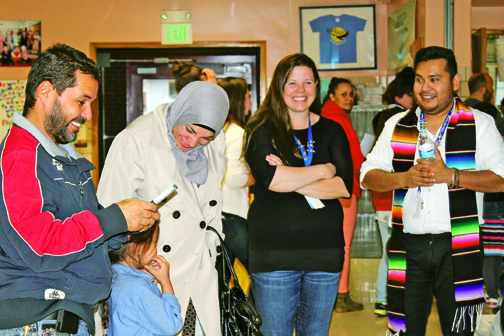 Residents of Virginia Village treasure the “back in time” feeling of their neighborhood, which was built in the 1950s. Ranch and split level-style homes, typical of that period, dot the quiet streets. There’s even a neighborhood school set back upon a wide lawn: Ellis Elementary.
Residents of Virginia Village treasure the “back in time” feeling of their neighborhood, which was built in the 1950s. Ranch and split level-style homes, typical of that period, dot the quiet streets. There’s even a neighborhood school set back upon a wide lawn: Ellis Elementary.
Ellis, however, is not typical of the 1950s.
While that decade was marked by conformity, roughly half the students at Ellis hail from countries other than the U.S.
In the 1950s, differences were kept under wraps. Not so at Ellis, where even as staff welcome newcomers to the American way of life, they encourage them to remember their own.
“We feel diversity is what made America strong. We know it is what makes Ellis stronger,” declares principal Nichole Whiteman, whose students hail from the nearby neighborhood — and from China, Mexico, Thailand, Ethiopia, Iraq, and a host of other far-flung places. “Our community is smarter, richer, more joyful and simply better because of our diversity,” Whiteman insists.
Some months ago, absorbing news of travel bans, Whiteman sat down with a few of her teachers and pondered how they could honor the school’s population. Ideas became a vision. Shortly thereafter — at 5:30 p.m. on March 22 — Ellis’s front doors opened to eager crowds. Ellis Elementary Celebrates our Diversity: A School without Borders Event had begun.
An Amazing Night
Ellis parent Mark Ginkel arrived in a kilt that bespoke his Irish ancestry. Baidan Alameri, in a fuchsia hijab, carried in a strawberry pink dessert. Other delicacies brought by parents — flan, magrud, kunata — made the cafeteria one of the evening’s most popular stops, beside the art exhibit, the Family Portraits and the resource fair, complete with immigration attorneys, healthcare workers 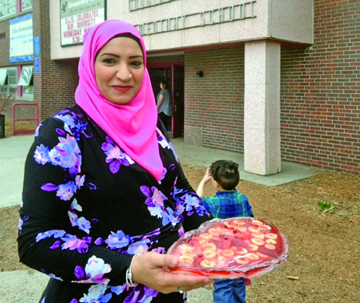 and representatives from the Denver Art Museum.
and representatives from the Denver Art Museum.
In the lobby, Ellis students introduced themselves on a video. “My name is Ibrahim; I speak English and Arabic because my family is from Morocco.” “My name is Alex, I speak Burmese because my family is from Burma.” The tag line was what each child wished others knew about their culture; e.g., “I wish you knew that in our culture, we ride elephants.” One little girl said, “I wish you knew that Mongolia is similar to America.”
In the auditorium, young authors read original compositions. A rapt audience heard 10-year-old Jadea Swindler proclaim, “I want to be a singer and a dancer … Never give up, what you want and what you dream for!”; Karla Lozano and Ruth Rosas ask, “Promise me something, never judge someone by their color or the language they speak” and two high school boys recite earnest poetry: “This is not a revolution of hate and revenge/ It’s a revolution of love, of justice. … This is my American dream.”
Giddy with goodwill, attendees beamed at each other in the halls. “It was an amazing night,” Whiteman recalls. “There was such a feeling of hopefulness and togetherness. I hope to fill the halls of our school with that feeling every single day.”
The Whole Picture
Whiteman has her work cut out for her. Besides endeavoring to create a veritable Peaceable Kingdom, she’s got to worry about test scores.
In the Denver school system (DPS), children take annual tests which compare their academic knowledge with same-age peers across the state. Schools are given a numerical rating based on the average of all their students’ scores. When educators speak of “high” or “low performing” schools, this rating is what they mean. But how can Ellis — with many students fresh from traumas like poverty and a sudden absence of the familiar, with a good chunk of them grappling with English as their new language — be rated accurately?
School ratings are posted without comment. For its low score, Ellis wins only a C- from Greatschools.org, only one star from Schooldigger.com. (A more comprehensive analysis on the DPS site ranks Ellis only as “challenged.”)
But if one looks (clicks) further, reviews voicing profound satisfaction stream into view. “My son has attended Ellis since 3rd grade. He is a GT [Gifted/Talented] student … I cannot say enough about the teachers’ abilities and drive to educate … “
“This is a school full of wonderful teachers and committed staff. It is a school for learning ….”
“This school is a GEM!! I have had opportunities to send my son to different schools but elected to keep him at Ellis due to their ability to keep him academically challenged … “
“Unfortunately,” Whiteman observes, “when a school is judged primarily on one standardized assessment and that’s what gets publicized, people are missing a huge piece of the puzzle.”
Building Character As Well As Test Scores
Which is not to say Whiteman doesn’t place importance on testing. “We work hard to increase academic outcomes … Our local data show that our students are improving.
“We soar toward excellence in academics and also in character development,” she emphasizes. “We teach values: integrity, perseverance, curiosity, optimism, respect and compassion.”
“I like how they focus on character development,” says Jim Moody, whose son is in second grade at Ellis. “It permeates every part of the school.”
Former Ellis parent Steve Garcia attests, “My son learned leadership as well as academics.”
Another parent states, “At Ellis, I know [my child’s] emotional well being is taken into account by every adult he comes into contact with.”
A Noble Experiment
It seems almost too great a coincidence that Ellis Elementary shares the name of the famous immigrant gateway in New York. Whiteman notes, “It’s wonderful to see friendships where the color of skin or religion is clearly just not a factor.”
Some parents see how such friendships can shape their child’s future. One writes, “At Ellis, my son has the opportunity to navigate cultural and linguistic differences. The connections he makes because of this cannot be taught, they must be lived and experienced. I feel confident he will leave with a dedication to humanity that will prepare him for the challenges of our global community.”
Brooke Webb, who recently became the Director of Ellis’s Parent Teacher Organization (PTO), agrees that Ellis affords rare opportunities. “A few years ago when our daughter was Kindergarten age, we turned to Ellis because we like supporting our neighborhood school. Then Olivia began and I got really impressed: academic excellence and this amazing celebration of diversity!”
Webb would like more of her neighbors to see Ellis’s  value. For though the school is located in Virginia Village, families don’t have to send their kids there.
value. For though the school is located in Virginia Village, families don’t have to send their kids there.
Choosing Ellis
“Within DPS, parents have this thing called choice,” Webb explains. “They can choose any school within the system. Many parents choose schools that have more white faces.”
There are common misconceptions, Webb says. “People say, ‘Don’t you feel funny being the minority?’ But we’re not; there’s like 20 percent of everything represented. The majority/minority paradigm doesn’t have a chance to get started! And, ‘Isn’t your child held back because all the attention goes to the kids who don’t speak English?’ But the truth is, there’s no additional time given to kids learning English. They get that in language development classes.
“Our belief in our choice is reinforced by all the terrific ben efits we see Olivia getting.”
efits we see Olivia getting.”
Right now, Ellis Elementary is supported by dedicated staff, a recently revived PTO and a population that draws equally from a stable neighborhood and a changing world. The school faces challenges. Gentrification may close affordable housing in the area. Low test scores might dissuade potential parents.
“But we love the school and we’re up to it,” Webb says. “I see strollers on the streets here, so many kids who’ll be school age soon. I want to educate them! I want to tell them just how great their neighborhood school is.”

by Mark Smiley | Apr 28, 2017 | Main Articles
A $7.7 Million Bond Issue Would Widen Sidewalks, Add Public Art, Better Lighting Plus A Pedestrian Plaza
by Glen Richardson
 A walk along Denver’s Art District on Santa Fe can be both depressing and refreshingly optimistic. An intermingled blend of debris, flimsy sidewalks and bric-a-brac storefronts, it is the intersection between run-down buildings and a fun, fulfilling wellspring of art. This unfinished strip of street art offers a sketchy peek at the district’s future as the city around it changes. That’s because — as the Santa Fe strip has already proven — art can change things.
A walk along Denver’s Art District on Santa Fe can be both depressing and refreshingly optimistic. An intermingled blend of debris, flimsy sidewalks and bric-a-brac storefronts, it is the intersection between run-down buildings and a fun, fulfilling wellspring of art. This unfinished strip of street art offers a sketchy peek at the district’s future as the city around it changes. That’s because — as the Santa Fe strip has already proven — art can change things.
The artistic street canvas between 7th and 12th avenues on Santa Fe Drive has emerged as a national standout over the last decade. The initial First Friday art event here in 2003 drew 20 people to two galleries. Last year’s summer edition attracted Friday night crowds of 14,000. But now the district is at a crossroads as sidewalks crumble 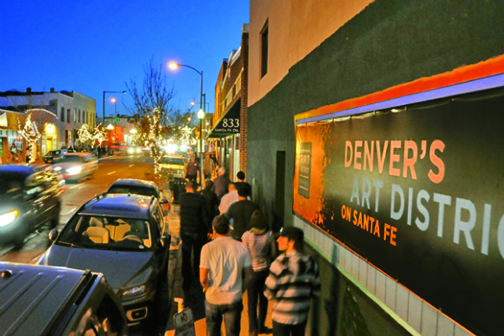 and the street hasn’t seen infrastructure improvements in 30 years.
and the street hasn’t seen infrastructure improvements in 30 years.
The district is seeking to get a $7.7 million General Obligation Bond on Denver’s November ballot. The plan would eliminate one lane of traffic to make room for wider, ADA-compliant sidewalks, add upgraded lighting, branded signage and public art. In addition, a pedestrian-only plaza would be built on 9th Ave. between Santa Fe Drive and Inca St.
Consequences Of Change
Despite the district’s success, infrastructure improvement and other proposed changes risk upsetting the tricky balance between art and commerce. Rents have been rising in recent years forcing artists to move out. Furthermore, escalating real estate prices are already a roadblock for up-and-coming artists lo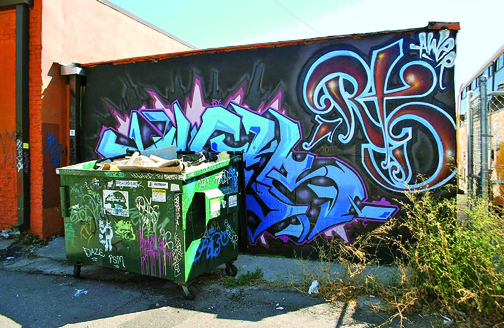 oking to plant roots in the district.
oking to plant roots in the district.
Moreover, Santa Fe Drive from 1st north to 13th Ave. is emerging as a more mixed-use district. New restaurants and breweries have opened and more are on the way. The influx of new businesses creates a double-edged sword. People want restaurants, bars, nightlife and boutiques. The changes, however, create gentrification, pushing rents higher and forcing art studios out. Growth and transformation is also threatening the district’s historic Latino culture.
In the late 1990s and early 2000s, as rents jumped on Broadway and in the Ballpark neighborhood, artists started looking for cheaper studios and galleries. The old buildings on Santa Fe Drive were ideal, and soon there was a critical mass of galleries a mile south of downtown.
Creative Class
Jack Pappalardo bought a building and opened a studio and gallery here in 2003 and became the Art District’s first president. Working from a classic live-work space at 828 Santa Fe Dr., he lowered membership dues, broadened the base and created what he calls the “rise of the creative class.” The tactic work ed and membership jumped to 70 artists and businesses during his 10-year tenure as president.
ed and membership jumped to 70 artists and businesses during his 10-year tenure as president.
During his first five years as president membership grew steadily. Then in 2006 photographer John Fielder relocated his gallery here from Cherry Creek North. That, according to Pappalardo, was the District’s “stamp of approval.” Two more important newcomers followed in 2010: Su Teatro acquired the Denver Civic Theater and Metro State University opened the Center for Visual Art. Then in 2013 Colorado Ballet purchased and renovated a 100-year-old building at 11th and Santa Fe. The renovated 30,000-sq.-ft. structure opened the following year as the Armstrong Center for Dance.
Destination Development
Amy Phare, who took over from Pappalardo as president and also lives in the district, says the remake isn’t just about Friday night art crowds. Changes are being m ade to further the economic development of the corridor. Like Pappalardo before her, she says the plan will make it a neighborhood street. She says the plaza would serve both as an “art park” and a “community gathering place.”
ade to further the economic development of the corridor. Like Pappalardo before her, she says the plan will make it a neighborhood street. She says the plaza would serve both as an “art park” and a “community gathering place.”
Actually the plan, according to both, “harks back to the days when Kalamath St. and Santa Fe Drive were two-way streets. That was before the suburban boom of the 1970s-’80s led to development of feeder routes heading downtown.”
The new plan would make Santa Fe a neighborhood street again. That means reinventing the district as a walkable neighborhood that’s an endpoint, not a cut through. We want Santa Fe Drive to be a destination,” emphasizes Phare. “We have kids here and we want this to be a safe destination, not a thoroughfare or a highway. Undeniably the street shouldn’t be a speed zone.”
Artistic Blueprint
Architect Mark Raeburn of Quantum Urban Architecture + Design (QUA+D) designed the proposed changes to the district. They highlight accessibility, safety and sustainability. “The sidewalks don’t meet the Americans with Disabilities Act or the city’s pedestrian plan,” he notes. “They simply aren’t safe right now.”
He points out that at certain bottlenecks, there’s two feet between gas meters mounted on storefronts and streetlights. “Moreover Raeburn says, “The sidewalks are crumbling plus people can’t walk together side by side.”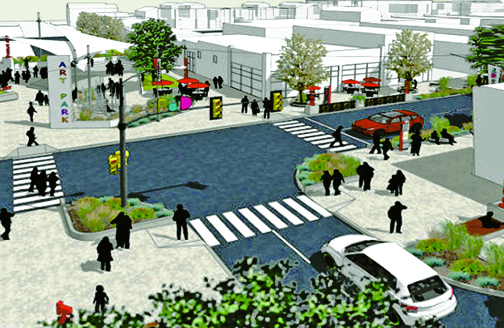 He adds, “I can’t tell you how many times I’ve walked into a light pole.”
He adds, “I can’t tell you how many times I’ve walked into a light pole.”
Raeburn’s plan also calls for the elimination of one lane of traffic to make room for wider, ADA-compliant sidewalks, and adding upgraded lighting. Branded signage and public art would motivate excitement and stimulate business. A pedestrian-only plaza is also proposed on 9th Ave. between Santa Fe Drive and Inca St.
Drawing A Bottom Line
First Friday is the one night galleries in the district really make money. Street closures plus a new art film series in the CVA parking lot adds enthusiasm and is creating new sponsorship opportunities. Nevertheless, as attendance has grown the event has become more of a party. The Third Friday Collector’s Preview gives artists and gallery owners a chance to meet art patrons in a subdued setting w ith a more mature, sober crowd.
ith a more mature, sober crowd.
Muralist Forrest Morrison who has a gallery in the district says, “I think we all recognize that an art district cannot survive without development that sustains and complements the creative sector and working-class artists.” He believes a united real estate identity would help stabilize rents and ensure they won’t lose the community and culture that has made the neighborhood so valuable.
Ultimately the artists here say it’s about the creative people who work and exhibit on the street. “You can’t start an art district,” says artist Georgia Amar, Pappalardo’s wife. She calls the Art District on Santa Fe a “grassroots, bottom-up” phenomenon. It’s about the artists, their work and their ability to make a living. She believes the quality of art is getting better and better. Her conclusion: “Now we have to focus on the real McCoy.”

by Peter Boyles | Apr 28, 2017 | Blasting with Boyles
 Saudi Arabian wealth has many surrogates in the state of Colorado. The powerful shadow and overreach of the Kingdom of Saudi Arabia into the offices of power and influence in Colorado grows daily. Its tentacles reach into former Governor Bill Owens, Colorado Springs Mayor John Suthers, Governor John Hickenlooper, attorney Hal Haddon, attorney Jack Finlaw, former United States Attorney General for the District of Colorado Henry Solano and perhaps most shocking, super lawyer and lobbyist Norman Brownstein who is beginning to be called in some circles “Norm of Arabia.”
Saudi Arabian wealth has many surrogates in the state of Colorado. The powerful shadow and overreach of the Kingdom of Saudi Arabia into the offices of power and influence in Colorado grows daily. Its tentacles reach into former Governor Bill Owens, Colorado Springs Mayor John Suthers, Governor John Hickenlooper, attorney Hal Haddon, attorney Jack Finlaw, former United States Attorney General for the District of Colorado Henry Solano and perhaps most shocking, super lawyer and lobbyist Norman Brownstein who is beginning to be called in some circles “Norm of Arabia.”
In several past columns, we attempted to chronicle the ties of the wealthy Saudi Arabian royal family and the Saudi government to Colorado.
But I believe it’s time to go to 25-thousand feet and really attempt to do an overview of how much influence the Saudi Arabians have in the Bush administration, the Obama administration, the Hickenlooper administration and perhaps as far back as Bill Owens’ tenure as governor of Colorado.
These wealthy Saudis, I believe, have had an enormous influence in politics, criminal justice, the media and both the Republican and Democratic parties.
If you remember what’s now known as “The 28 Pages” is really a “who dun it” of what happened on that terrible day of 9/11 and the involvement of the Saudi Arabians. That’s the view from 25-thousand feet.
When we come closer to the ground, we find the power of the Saudi Arabians so entrenched that they can have a sitting Attorney General of Colorado fly to Saudi Arabia on the behest of Republican Governor. That fact strikes fears in political circles in Colorado even in the Colorado media members.
It has become clear that Saudi Arabians were at the center of that terrible day of 9/11. George Bush and the dark lord Dick Cheney had those 28 pages in the Congressional Committee Report suppressed. Those were the 28 pages that spoke directly to Saudi Arabian planning and involvement in that terrible day.
We know of the meetings that George Bush had with Prince Bandar. We know Bush and Cheney created a false link between Iraq and 9/11. Secretary of Defense Donald Rumsfeld claimed, “My interest is to hit Saddam.” The phony Bush terrorism reports tried to link Saddam Hussein into Al Qaeda and 9/11
What great sadness. The real culprits have never been held accountable.
Here in Denver, as they say “the river runs through it.” Take the case of Homaidan al Turki, the man who was convicted of holding an Indonesian woman as a sex slave in the basement of his Highlands Ranch home.
He was convicted of 12 felony counts including false imprisonment, unlawful sexual contact theft and criminal extortion.
He was sentenced eventually to a minimum of eight years in prison but Governor Bill Owens feels obligated to sends his then Attorney General John Suthers (current Mayor of Colorado Springs) to Saudi Arabia to tell wealthy Saudi Arabians, including the King about our criminal justice system as it relates to Homaidan al Turki.
Since the last time I wrote about this I received a phone call from former Governor Owens who told me that on his own he decided to send Suthers to meet King Abdullah. Nice try.
I don’t buy it.
With all respect governor, why did your office not return requests from Congressman Tom Tancredo’s office about who paid for the trip, how many people went on the trip, the purpose of the trip and why you decided to send Suthers?
Suthers flew 19 hours and we’re not sure if you as the taxpayers paid for this. The Bush administration paid. And Suthers now claims King Abdullah offered to reimburse the tab. Suthers also called it the adventure of a lifetime.
As has been stated before. For God’s sake, you’re the attorney general of Colorado, not Saudi Arabia.
Does anyone else wonder how much money it takes to become Mayor of Colorado Springs?
But if it had ended there it would probably be no big deal. Just Republicans and Saudi Arabians. The Bushes and others doing what they do.
But the next chapter really gets dark.
Remember earlier we spoke about the 28 pages? Every high priced, fast-gunned lawyer that the Saudis could hire tried to make al Turki a young man studying for his doctorate in linguistics. But when we finally get a glimpse of the 28 pages guess who appears?? That’s right. Homaidan al Turki. You little dickens.
We now know he was in communication with the 9/11 conspirators in Germany. In the weeks and months before 9/11. Homaidan and his friend Anwar al-Awlaki (himself killed by a U.S. drone strike in Yemen in 2011) was at the time living here in Denver doing his incredible series titled “The Lives of the Prophets.” A series of Islamic history recordings made by Alwaki in the 1990s. Just a couple of funsters.
Al Turki appears and reappears some 14 times in the suppressed 28 pages. I’m sure al Turki thought about flying back to Saudi Arabia but he and other royal family members were being protected by George W. Bush. Why run?
I believe the Saudis thought they could buy al Turki out of Colorado. We’re led to believe that his ouster from the penal system was good to go, the work of fast John Hickenlooper’s attorney Jack Finlaw, criminal attorney Hal Haddon and various others all working to get the “innocent” little guy back to Saudi Arabia where he would simply walk away. It didn’t happen that way and I believe that set up the murder of Department of Corrections Chief Tom Clements and pizza delivery man Nathan Leon.
Most people have heard that story. But the Front Range media covered up the truth of it so many times that I really don’t know what the average person believes about those two murders.
We can, however, read in the Texas Rangers’ report that Jack Ebel, father of Clement’s murderer and 2/11 gang member Evan Ebel was indirectly involved with 211 prison gang because of his son. Jack Ebel is also a longtime friend of Governor John Hickenlooper. Evan Ebel I believe was simply carrying out the wishes of the wealthy Saudi families.
To add insult to injury the Saudis are now attempting to knock down JASTA, the legislation that will now allow 9/11 victims’ families and survivors to sue Saudi Arabia. Once again money changes hands in Colorado.
The Saudis hire Norm of Arabia’s prestigious law firm, Brownstein Hyatt Farber Schreck, who are now doing everything they can to help the Saudis to the tune of $100,000 a month.
Learn anything? I know I have. None of these people are to be trusted.
Thanks for reading this.
Watch the skies.
— Peter














